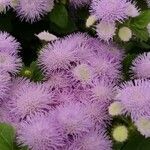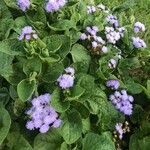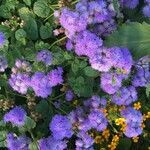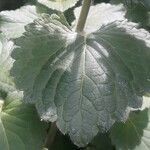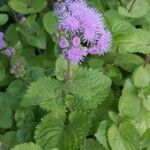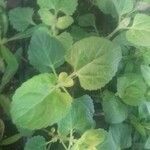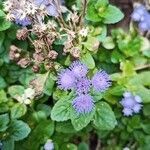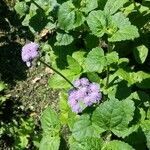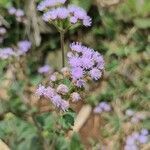Usually annual or short-lived perennial, erect to decumbent, simple or sparingly branched herb or sub-shrub to 1 m; stem terete, whitish pubescent and with some long, simple hairs. Leaves opposite to occasionally sub-opposite above, with pubescent petiole 0.4-3.2 cm, blade triangular to ovate, 1.3-5.8 cm long, 1-5.3 cm wide, base cordate to abruptly truncate, margins crenate to serrate, apex acute or obtuse, dark green, moderately hirsute above, a little paler, glabrous to sparsely hirsute beneath. Infloresence terminal, ±7-60 heads borne in tight cymose clusters on pubescent and hirsute bracteolate common stalks; capitula 4-7 mm diameter, stalks of individual capitula 0-6 mm extending to 12 mm in fruit; phyllaries green, lanceolate, usually 2-ribbed, outer series 3.5-4.5 mm long, 0.8-0.9 mm wide, inner slightly narrower, margins entire, apex acuminate, often purple, hirsute and glandular-stipitate especially basally. Florets 70-103, corolla-funnel shaped, 2.5-3 mm long, tube white, limb blue, mauve, or white, lobes acute, sparsely to moderately short-pubescent; anthers basally subcordate; style-arms blue, mauve or white, clavate, exserted for ±2.5 mm, papillate. Achenes 1.2-2 mm long, sub-glabrous, with occasional setae between ribs; pappus 0-3 mm long, of 5 free triangular scales, lacerate, acuminate into a slender awn with scabrid margins, or pappus awnless, scales coroniform, truncate, lacerate, or occasionally pappus absent.
Herbs, annual, 30-70(-100) cm tall. Stems erect, simple or branched from middle or lower part; stems and branches purple-red, green, or straw-colored, white tomentose or thinly lanate. Leaves broadly ovate or triangular-ovate; petiole 0.7-3 cm; median stem leaves 2-6 × 1.5-3.5 cm, or length equal to width; upper and axillary leaves smaller; all leaves basally 3-veined or inconspicuously 5-veined, both surfaces sparsely or densely white pubescent, base cordate or truncate, margin crenate-serrate, apex rounded or acute; petioles of upper leaves and axillary branches usually spreading white long tomentose. Synflorescence corymbose, 2-4 cm in diam.; peduncle densely pubescent or powdery pubescent. Capitula 5-15 or more; involucre campanulate, 6-7 mm in diam.; phyllaries 2-or 3-seriate, narrowly lanceolate, 4-5 mm, abaxially glandular pubescent, margin entire, apex long acuminate; corollas tubular, 2.5-3.5 mm; limb purplish; lobes pubescent. Achenes black, 5-angled, 1.5-1.7 mm; pappus of 5 short free scales; scales oblong-lanceolate, 2-3 mm, apex aristate-acuminate, sometimes truncate and 0.1-1.5 mm. Fl. and fr. year-round. 2n = 20, 40.
Annual or short-lived perennial erect herbs or subshrubs to 0.9 m tall, sparingly branched; stems greenish to slightly reddish, terete, slightly striate, usually broadly fistulose, long-pilose and minutely puberulous. Leaves mostly opposite; blades broadly ovate to deltoid, to 10 cm long and 8 cm wide, the base usually truncate or slightly cordate, strongly trinervate, the margins crenate to serrate-crenate, the apex short-acute to narrowly rounded or obtuse, the upper surface dull green, sparsely long-pilose, the lower surface scarcely paler, sparsely long-pilose on the veins and veinlets, glandular punctations often lacking; petioles to 4 cm long. Inflorescence cymose to subcorymbose with densely corymbose to subumbellate branches, the branches densely puberulous with few to many longer hairs, the ultimate branches 1-8 mm long, not or scarcely enlarged distally. Heads 4.5-6.5 mm high with 50-75 florets; involucral bracts 20-30, eximbricate, in 2 series,
mostly 3.5-5.0 mm long, oblong-lanceolate to lanceolate, prominently bicostate, with scarious margins which are sometimes irregular above, the apex usually very sharply acute, rarely scarious near tip, the outer surface sparsely to densely pilose; receptacle naked; corolla and style branches usually bluish; corolla 2.3-3.0 mm long, narrowly funnelform, the somewhat tubular base ca. 1 mm long with a few minute glands, the limb usually glabrous, the lobes 0.3-0.4 mm long, papillae within, at the tip and on margins, many short hairs on outer surface; style branches slightly enlarged distally and usually very prominent, papillae small and somewhat pointed. Achenes ca. 1.2 mm long, with sparse short bristles usually restricted to the ribs; carpopodium asymmetrical; pappus of 5 large free scales, the scales usually lanceolate with a long slender apical awn, 2.0-2.5 mm long with awns.
Erect or ascending annual herb, up to c. 1 m tall. Stems densely clothed in long eglandular and short glandular hairs above, becoming almost glabrous and sometimes somewhat woody toward base. Petiole hairy and glandular, 5-20-(50) mm long; lamina hairy and glandular especially on lower surface, ovate to ovate-triangular, acute, truncate to cordate, crenate-serrate, (12)-25-60-(100) × (12)-15-50-(70) mm; uppermost lvs smaller, sometimes with few teeth. Capitula c. 3-7 mm diam., in dense clusters; peduncles hairy and glandular. Involucral bracts ± equal, sometimes with supplementary bracts outside, oblong-triangular to lanceolate, acuminate, hairy and glandular, 4-5-(6) mm long. Florets usually blue and with conspicuous blue stigmas, rarely corolla and stigmas white. Achenes black, sparsely hairy, 1.4-1.8 mm long, with 5-(6), aristate, fimbriate scales.
Annual or short-lived perennial herb, erect or decumbent, 0.3–1 m high, softly hairy or nearly glabrous. Leaves with petiole 5–50 (–65) mm long; lamina ovate to deltoid, (10–) 20–90 (–100) mm long, (10–) 15–60 mm wide, rounded to cordate or truncate at base, serrate to crenate, acute to obtuse, with scattered hairs on both surfaces. Inflorescence of 5–15 heads in a compact corymb. Capitula ±globose, 5–8 mm diam.; involucral bracts linear-lanceolate, c. 5 mm long, entire, long-acuminate, coarsely hairy and glandular-ciliate, especially towards tips. Florets blue-mauve. Achenes narrowly oblong, c. 2 mm long, glabrous or sparsely hairy, black. Pappus scales c. 5, 2–3 mm long, free at base, shortly fimbriate on margins or glabrous, awned, white.
Annual herb or subshrub, 0.3-1.0 m high. Leaves opposite or upper alternate, entire or dentate, with large glandular spots on lower surface. Capitula discoid; many-flowered, in dense corymbs or occasionally a lax panicle; involucre campanulate; bracts in 2 or 3 rows, free, ribbed, with membranous margins. Receptacle honeycombed, conical. Corolla mauve; tube cylindric below, campanulate above; lobes 5, much shorter than tube, glandular. Anthers obtuse at base, with oblong, apical appendage. Style terete, with short glandular branches. Flowering time Sept.-Feb. Pappus of coroniform scales. Cypselae 5-ribbed, glabrous or short-setose on ribs; carpopodium usually large and asymmetrical.
Annuals, 30–80 cm (fibrous-rooted). Stems erect to decumbent, sparsely to densely pilose. Leaf blades deltate to ovate, mostly 3–8 × 2.5–4 cm, margins toothed, abaxial faces sparsely to densely pilose, not evidently gland-dotted. Peduncles viscid-puberulent, pilose, and stipitate-glandular. Involucres ca. 4 × 5–6 mm. Phyllaries narrowly lanceolate (0.6–1 mm wide), stipitate-glandular, sparsely to densely pilose, eciliate or inconspicuously ciliate, tips gradually tapering, indurate-subulate, 0.8–2 mm. Corollas usually lavender, rarely white. Cypselae sparsely strigoso-hispidulous; pappi of 5 distinct, oblong scales 2–3 mm. 2n = 20.
Annual herb, up to 1 m high. Leaves opposite. Heads 6-7 mm across. Involucral bracts linear-lanceolate, attenuate, entire, ciliate on back, many of hairs glandular. Flowers purplish, bluish or white.
